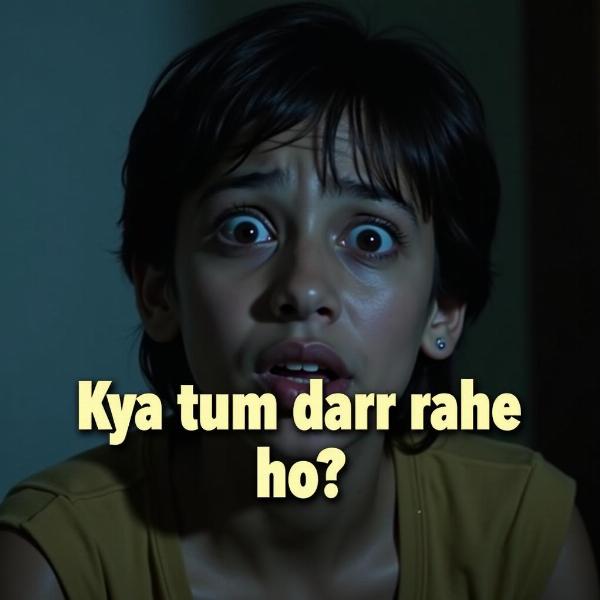Are you afraid meaning in Hindi encompasses a range of words and expressions that reflect the nuances of fear, anxiety, and apprehension. Understanding these nuances is crucial not only for language learners but also for anyone seeking to delve deeper into Indian culture and its perspectives on emotions. This article explores the various ways to express “are you afraid” in Hindi, examining their contextual usage and cultural implications.
Different Ways to Say “Are You Afraid” in Hindi
Several Hindi words and phrases convey the meaning of “are you afraid,” each with its own subtle connotations:
- Kya tum darr rahe ho? (क्या तुम डर रहे हो?): This is the most common and direct translation, suitable for most situations. It’s a general inquiry about someone’s fear.
- Kya aapko dar lag raha hai? (क्या आपको डर लग रहा है?): A more polite and respectful way to ask, using the formal “aap” instead of the informal “tum.” Ideal for addressing elders or superiors.
- Kya tum ghabra rahe ho? (क्या तुम घबरा रहे हो?): This implies a sense of nervousness or unease, often associated with anticipation or anxiety rather than immediate danger.
- Kya tum bhaybheet ho? (क्या तुम भयभीत हो?): This word signifies a more intense and overwhelming fear, closer to terror or dread.
- Darpok ho kya? (डरपोक हो क्या?): This is a slightly provocative and informal question, implying that the person is cowardly. Use with caution as it can be considered rude.
 A person looking scared, asking "Kya tum darr rahe ho?"
A person looking scared, asking "Kya tum darr rahe ho?"
Cultural Context of Fear in India
Fear, like any emotion, is viewed through a cultural lens. In India, fear is often intertwined with spiritual beliefs, societal norms, and traditional narratives. Fear of the supernatural, for instance, is prevalent in folklore and often manifests in everyday rituals and practices. Respect for elders and authority figures can also influence the expression of fear, with individuals often hesitant to openly admit their anxieties.
Expressing Fear Beyond Words
While verbal expressions are essential, non-verbal cues also play a significant role in communicating fear in Indian culture. Gestures, facial expressions, and body language often convey apprehension more effectively than words. Avoiding eye contact, fidgeting, and a lowered head can all indicate fear or discomfort.
Are You Afraid of the Dark? (Kya Tum Andhere Se Darte Ho?)
This specific question, “are you afraid of the dark?” translates to “Kya tum andhere se darte ho?” (क्या तुम अँधेरे से डरते हो?) in Hindi. It exemplifies how the preposition “se” (से) is used to express fear of a specific object or situation.
What Makes You Afraid? (Tumhe Kis Cheez Se Dar Lagta Hai?)
To understand the source of someone’s fear, you can ask “Tumhe kis cheez se dar lagta hai?” (तुम्हें किस चीज से डर लगता है?). This translates to “What makes you afraid?” This question encourages a more open and detailed response.
Conclusion: Navigating the Nuances of Fear in Hindi
Understanding the various expressions of “are you afraid” in Hindi provides a valuable insight into the complexities of human emotion within a specific cultural context. From simple inquiries to more nuanced expressions, the language offers a rich vocabulary to explore the spectrum of fear. Whether you’re learning Hindi or seeking a deeper understanding of Indian culture, knowing how to express and interpret fear is crucial for effective communication and cross-cultural sensitivity.
FAQ
- What is the most polite way to ask “are you afraid” in Hindi? The most polite way is “Kya aapko dar lag raha hai?” (क्या आपको डर लग रहा है?).
- How do you say “I am afraid” in Hindi? You can say “Mujhe dar lag raha hai” (मुझे डर लग रहा है) or “Main darr raha/rahi hoon” (मैं डर रहा/रही हूँ).
- What are some other words related to fear in Hindi? Bhay (भय), traas (त्रास), and andhera (अँधेरा – darkness) are some related words.
- Is it considered rude to ask someone if they are afraid in India? It depends on the context and the specific phrasing. Using informal language with elders or superiors can be disrespectful.
- How does Indian culture view fear? Fear is often intertwined with spiritual beliefs and social norms in India.
- What are some non-verbal expressions of fear in Indian culture? Avoiding eye contact, fidgeting, and a lowered head can indicate fear.
- How do I ask about a specific fear, like fear of heights, in Hindi? You can use the preposition “se” (से) and the noun for the feared object, for example, “Kya aapko oonchai se dar lagta hai?” (क्या आपको ऊँचाई से डर लगता है?) for fear of heights.
Related Articles:
- not negotiable meaning in hindi
- abhin meaning in hindi
- good better best never let it rest meaning in hindi
- fear of failure meaning in hindi
Meaning-Hindi.in is your trusted partner for professional Hindi translation services. We specialize in business, legal, technical, website localization, educational, and urgent translations, ensuring accuracy and cultural sensitivity. Our expertise covers a wide range of specialized fields, guaranteeing high-quality translations tailored to your specific needs. Contact us today for all your Hindi translation requirements at [email protected] or +91 11-4502-7584. Meaning-Hindi.in is committed to bridging the language gap and facilitating effective communication.